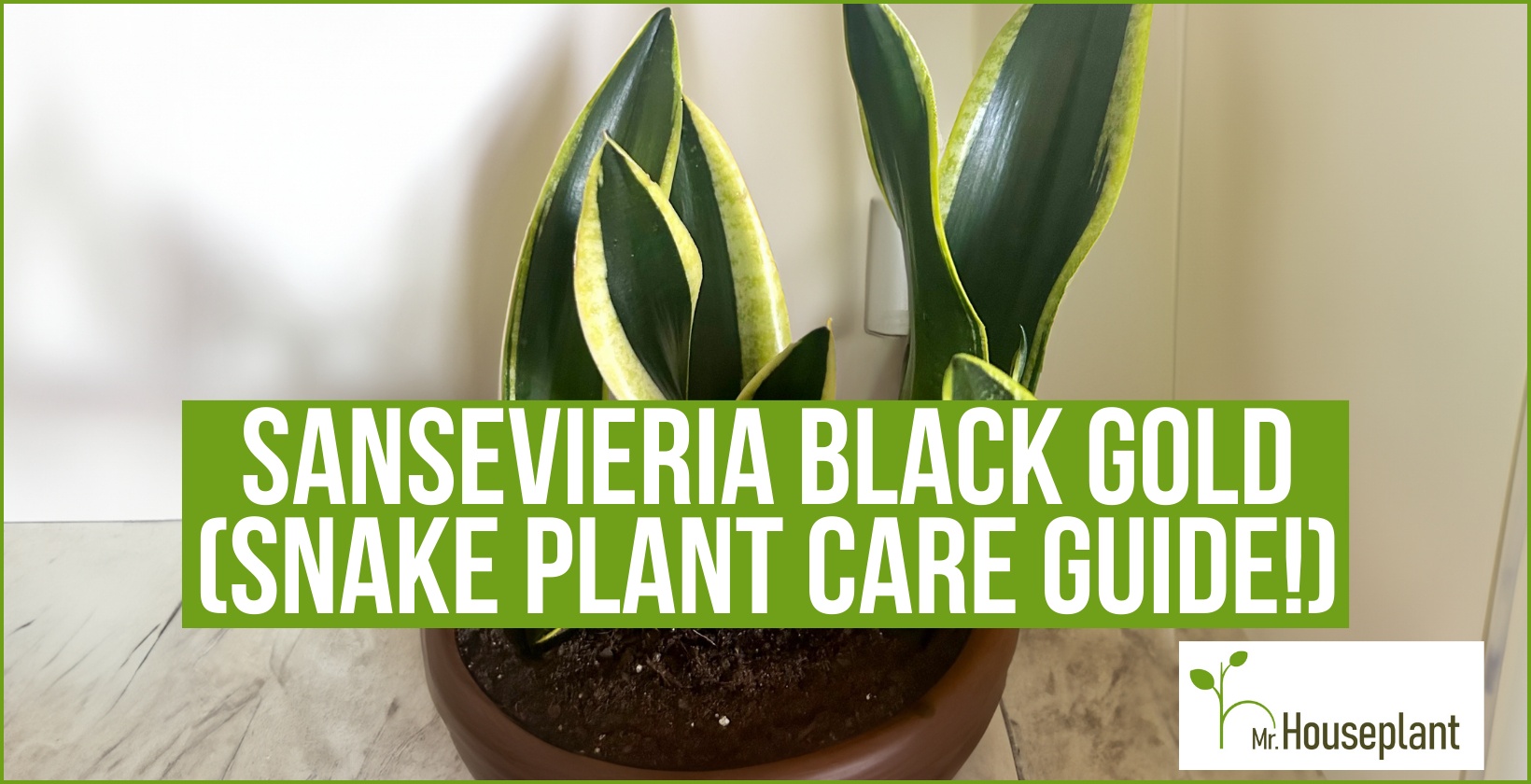
If you want to give your Sansevieria Black Gold Snake Plant optimal care so it can thrive, this is the right guide for you. From watering, light requirements, and fertilizing to soil and propagation, this guide has everything you need to be a responsible Sansevieria Trifasciata Black Gold parent. Keep reading to get detailed information about growing this captivating snake plant.
| Botanical Name (Latin Name/Scientific Name): | Sansevieria Black Gold |
| Common Name: | Snake Plant Black Gold |
| Light: | low light tolerant (750+ lux; 75+ foot candles); prefers direct sunlight or bright indirect light |
| Watering: | water once the soil dries out to the bottom of the pot |
| Soil: | succulent or cacti soil |
| Repotting: | once a year or when the snake plant breaks the pot |
| Fertilizing: | fertilize once a month or with 1:2:2 N-P-K fertilizer |
| Temperature: | warm temperatures between 65°and 75°F (18° and 24°C) |
| Humidity: | 5% to 25%, adapts well to higher humidity |
| Toxicity for Pets: | Yes (diarrhea, vomiting, nausea) |
| Toxicity for Humans: | Yes (vomiting or diarrhea, skin irritation) |
| Propagation: |
|
| Pruning: | prune dead or diseased growth |
What Is Sansevieria Black Gold?
Sansevieria Black Gold is a low-maintenance variety of Snake Plant that has dark, blade-shaped succulent leaves with gold edges. It’s an easy-to-care-for snake plant that is low light tolerant but will grow best in direct sunlight or partial shade. It’s native to tropical West Africa, like many other indoor plants.
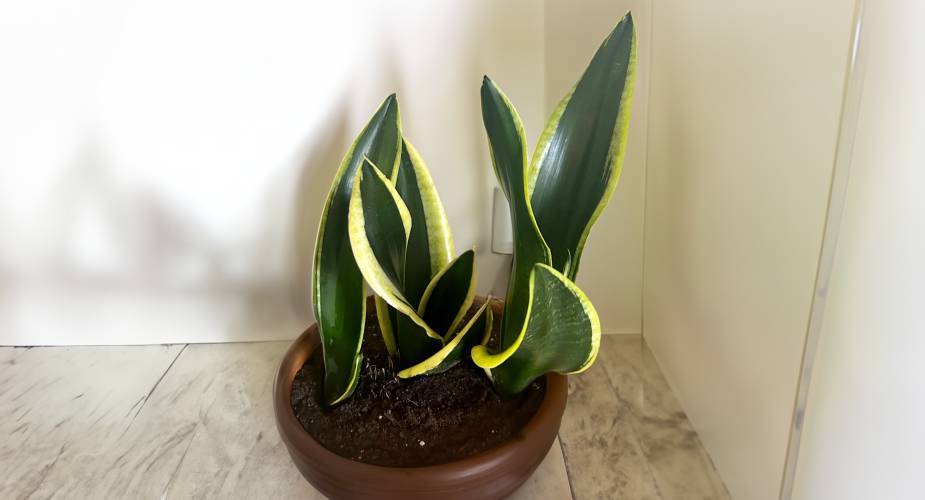
Snake Plant Black Gold
Sansevieria Black Gold Care
Sansevieria Trifasciata Black Gold care is easy. If you provide your Black Gold Sansevieria with optimal light (over 40,000 lux), water it once the soil dries out, and provide a succulent or cacti potting mix, it will flourish and reward you with beautiful foliage.
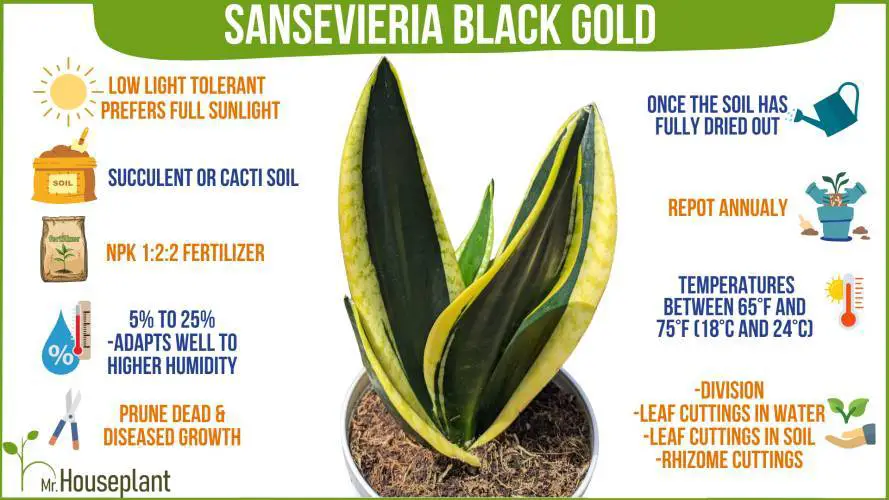
Black Gold Sansevieria Trifasciata care steps. Photo of the plant by: PotentialCrazy1
Light Requirements
| Minimal amount of light: | 50+ lux (5+ FC) |
| Optimal amount of light: | full sun: 40,000+ lux (4,000+ foot candles) |
| Direct sun tolerance: | 8+ hours |
| Category: | low light tolerant |
Sansevieria Trifasciata Black Gold does best in full sunlight, over 40,000 lux (4,000 foot candles). It will also grow well in bright indirect light (over 3,000 lux / 300+ foot candles) or partial shade. Sansevieria Trifasciata Black Gold is low light tolerant. It can tolerate light levels as low as 50 lux, but it will not thrive in this light and will become leggy.
Water Needs
Sansevieria Trifasciata Black Gold isn’t a very thirsty plant due to its thick and fleshy leaves and rhizomes that store water. Let the soil dry out completely before watering. The standard way to assess if your Black Gold Sansevieria Trifasciata is thirsty is to use a chopstick. Take a chopstick and stick it all the way to the bottom of the pot. Take the chopstick out and if it comes out completely dry, with no soil clinging to it, it’s time to water your Snake Plant Black Gold.
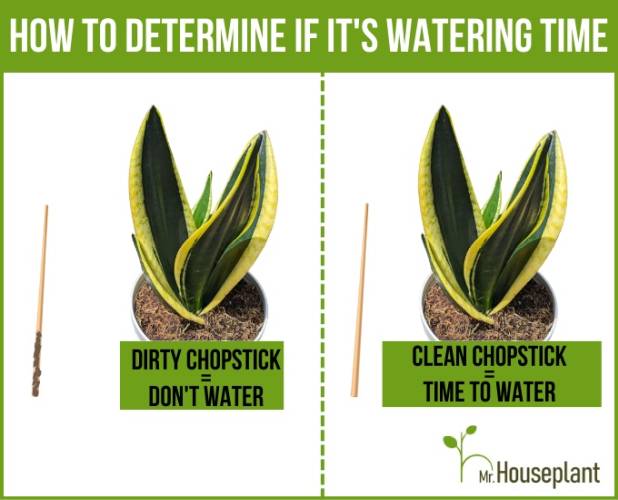
Dirty chopstick means to wait more before watering. Once the top half of the chopstick is clean and dry it’s time to water the plant. Photo of the plant by: PotentialCrazy1
Snake Plant Black Gold tolerates underwatering better than overwatering because of its thick leaves. Be careful not to overwater it as this will easily lead to root rot.
Humidity Needs
Optimal humidity levels for Sansevieria Trifasciata Black Gold are between 5% and 25%. However, this plant can adapt well to any humidity level.
Temperature Requirements
Sansevieria Trifasciata Black Gold, like its other tropical relatives, thrives in warm temperatures, between 65° and 75°F (18° and 24°C).
Fertilizing
Fertilize Sansevieria Black Gold every two to four weeks with a liquid fertilizer with a 1:2:2 NPK ratio. Follow the instructions on the label, as overfertilizing can damage your Black Gold Sansevieria.
If you repot your Black Gold Snake plant annually, it’s not necessary to fertilize it, since it will get all the nutrients from the soil.
Soil
The best soil for Sansevieria Trifasciata Black Gold is succulent or cacti soil. Succulent or cacti soil is well-draining and dries out fast.
I like to make my own potting mix by mixing 1 part perlite, 1 part bark, and 2 parts potting soil. I recommend using chunky amendments with large particles as this will create macro pores that contain oxygen. Adequate soil aeration is vital for root health and it helps keep fungal diseases at bay.
Repotting
To repot your Sansevieria Trifasciata Black Gold take the following steps:
- Gently take the Black Gold out of its pot
- Loosen the root ball
- Inspect the root ball. If you notice any dead, smelly, mushy, or diseased roots, cut them off
- Fill up ⅓ of the new pot with new soil (succulent or cacti soil). Pots with drainage holes are optimal, because the excess water can be expelled.
- Place your Sansevieria Trifasciata Black Gold into its new pot
- Fill up the pot with fresh soil
- Gently press the soil around your Snake Plant Black Gold
- Wait for the soil to dry out fully before you water
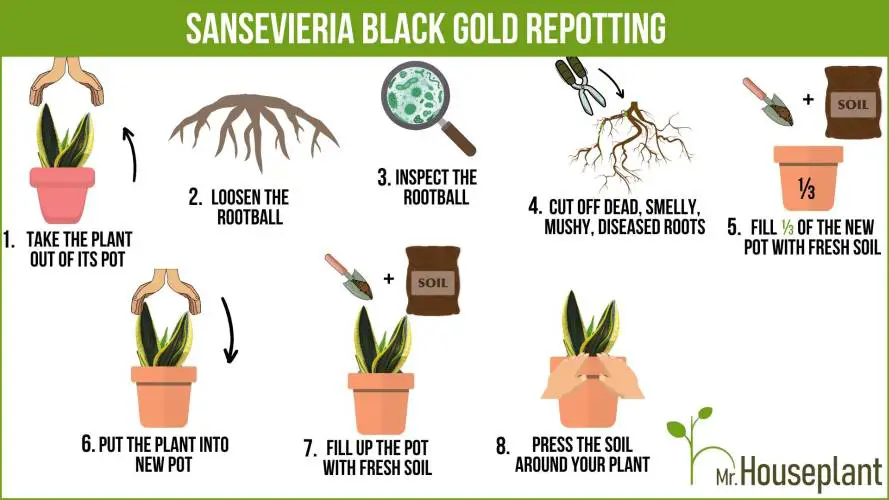
Follow these steps to repot the Sansevieria Black Gold plant. Photo of the plant by: PotentialCrazy1
You should repot your plant if it overgrows its container. You will know this if you see the plant’s roots coming out of the drainage holes. This is a sign that your Black Gold Snake plant needs to be repotted into a one-size larger container so it has room for growth. Even if it doesn’t overgrow its container, you should repot it once a year so it can get nutrients from fresh soil and continue growing in non-compacted soil.
Here is how I repotted my Whale Fin Snake plant:
Here is my video of Sansevieria Cylindrica repotting:
Toxicity To Humans
According to the University of California Poison Control System (CPCS), Sansevieria Trifasciata Black Gold is mildly toxic to humans. Ingesting Snake Plants can cause mouth and throat irritation, vomiting or diarrhea. Getting plant sap on the skin can cause skin rash and irritation. The following research and expert guidance illustrate these points:
Mouth and throat irritation, vomiting. Research from July 2019 by Prof. Hayk S. Arakelyan, Doctor of Medical Sciences from Tokyo Medical University Hospital confirms that the symptoms are often mild in humans and include mouth and throat irritation, nausea and vomiting.
Skin rash and irritation. Ann King Filmer, Ph.D. Plant Scientist from the University of California, in the publication “Safe and Poisonous Garden Plants” from October 2012 confirms that the sap of Sansevieria can cause a skin rash or irritation.
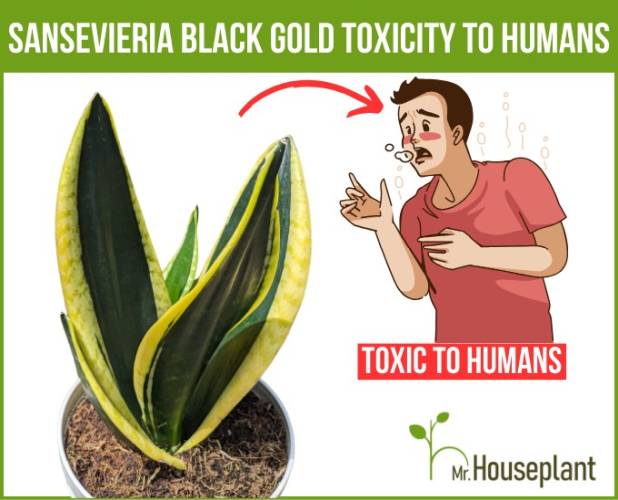
Sansevieria Trifasciata Black Gold is toxic to humans. Photo by: PotentialCrazy1
Toxicity To Pets
Sansevieria Black Gold is mildly toxic to pets according to the American Society For Prevention Of Cruelty To Animals (ASPCA). If you notice symptoms such as nausea, vomiting, or diarrhea, your pet has probably ingested Black Gold.
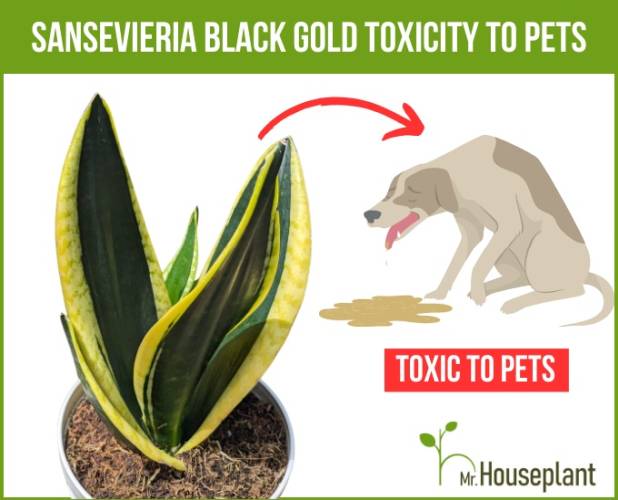
Sansevieria Black Gold is toxic to pets. Photo by: PotentialCrazy1
Pruning
You should prune Sansevieria Black Gold if it has dead or dry leaves or if the leaves show signs of bacterial or fungal disease. Always use sterilized and sharp pruning shears to prune your snake plants. To remove dead stems and dry leaves, just cut them off near the base.
Propagation
Sansevieria Black Gold can be propagated easily via division, stem cuttings in water, stem cuttings in soil or rhizome propagation. Here is how to propagate Black Gold Snake Plant via stem cuttings in water:
- Pick a stem and take a few inches long stem cutting with sharp and sterilized scissors
- If you want to maximize the chances of successful propagation, take a couple of cuttings
- Put the stem cuttings into a glass or another container with fresh water
- Put the containers with the stem cuttings in a warm place with bright light (over 3,000 lux; over 300 foot candles)
- Check the water periodically and replace it with fresh water once a week, or when it starts to get dirty
- Wait for new root growth. When the roots on the stem cuttings reach about 2 inches of length, plant the stem cutting into soil
- Eventually new plants will grow from the roots.
Here is my video of Snake Plant water propagation:
Here is my video of Snake Plant soil propagation:
Pests
Black Gold Snake Plants are susceptible to spider mites, mealybugs, and thrips which attack the leaves, sucking the sap out of them. To combat pests, spray the plant thoroughly with a mixture of 5 drops of 100% pure neem oil, 5 drops of dish soap, and 16oz of water. Neem oil disrupts insects’ feeding which causes them to die quickly. Keep the plant out of the direct sun for a few hours after the application, as the direct sun can cause leaf damage after neem oil application.
In case of a thrips infestation, besides treating with neem oil, also remove the old soil and wash the roots, as some species of thrips have a resting stage in the soil. To combat mealy bugs spray the plant with a solution of 1 part rubbing alcohol and 7 parts water.
In cases of severe infestations, you can use systemic insecticides.
Diseases
The most common diseases affecting Sansevieria Black Gold are:
- Soft rot (Erwinia carotovora)
- Red leaf spot (Fusarium moniliforme)
- Southern blight (Sclerotium rolfsii)
Soft rot is a bacterial problem present in Snake Plant propagation that is characterized by rot of the bottom part of the cutting, sometimes accompanied by a rotten, fishy smell. This smell is typical for Erwinia infection. Soft, mushy rot is another symptom and you will notice it on the lower end cuttings. The best option to reduce the chances of soft rot is to sterilize pruning tools before taking cuttings.
Red leaf spot (Fusarium moniliforme)
Red leaf spot is a fungal disease and usually appears on the newest Snake Plant leaves as irregularly shaped reddish brown lesions, often with a yellow border. If the leaves are wet, the chances of the red leaf spot increase. Lesions have an irregular shape and show up when there are spores and the whorl is wet. They have yellow borders and the color is reddish-brown. To prevent red leaf spot on your Snake plant, keep the leaves dry. To treat red leaf spot, consider applying a fungicide.
Southern blight (Sclerotium rolfsii)
Southern blight symptoms are displayed as water-soaked necrotic lessionslesions on the leaves. Prune all disease parts of the plant and make sure to sterilize pruning tools before and after pruning.
Common Problems
Leaves Turning Yellow
Sansevieria Black Gold can have yellow leaves due to several reasons: improper watering (overwatering or underwatering), bacterial disease, and pest damage. If the leaves are soft and mushy, the culprit is overwatering. Repot the plant in new, fresh soil, and cut off all soft and mushy roots. Make sure you’re watering once the soil has fully dried out, but also that you’re not leaving your plant without water for weeks at a time.
Inspect the plant closely for pests and any soft spots that could be caused by a bacterial infection. Treat for pest infestations with neem oil and cut off and discard any leaves with a bacterial infection.
Leaves Curling
Curling leaves on your Sansevieria Black Gold snake plants can be caused by severe underwatering or pest infestation. Make sure you are watering your Sansevieria regularly, once the soil has fully dried out. If you see a pest infestation, treat the plant with insecticidal soap, horticultural oil or neem oil. Also make sure to provide the plant with proper sunlight (over 40,000 lux), and a good succulent potting mix. Snake plants that get proper care are more resistant to pests and diseases.
FAQ
How Fast Does Black Gold Sansevieria Grow?
Sansevieria Black Gold is generally a very slow grower. The way snake plant grows is that it only puts out new growth once a year. Even though in the meantime it might seem it’s not doing anything, it is accumulating energy for producing new growth. If it’s kept in low or medium light, it will not get a lot of energy, and will not produce a lot of new leaves. The new growth will also be spindly. The more light you give it, the more leaves it will produce when it starts growing and they will be better looking and sturdier.
What Is The Difference Between Sansevieria Black Gold And Laurentii?
Sansevieria Black Gold has a darker leaf color compared to Laurentii and does not have the leaf stripes that Laurentii has. Black Gold is also a more compact plant, that doesn’t reach the same height as Laurentii.
Conclusion
Sansevieria Black Gold is an easy-to-grow plant if you ensure to meet its care requirements. If you apply all the tips and trick from this care guide, you will certainly be a proud plant parent of a lush and healthy Black Gold Sansevieria.
Yours Truly,


Related Posts
Spathiphyllum Sensation (FULLY Explained!)
Alocasia Stingray Care
Peperomia Verticillata ‘Red Log’